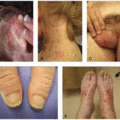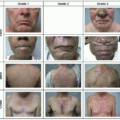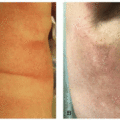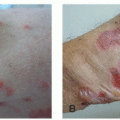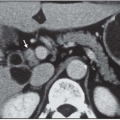Morbilliform Reactions
Connie R. Shi
Steven T. Chen
Morbilliform eruptions, or exanthematous eruptions, present with numerous erythematous, blanching, nonscaly 3 to 4-mm papules that can coalesce into larger plaques most commonly on the trunk and extremities (Figure 3.1). This type of eruption is frequently referred to as “maculopapular rash” in the oncologic literature. Morbilliform eruptions are commonly pruritic, and when extensive, can become confluent in appearance. Systemic symptoms are uncommon, but occasionally patients may experience a low-grade fever with this eruption. Mucosal surfaces are uninvolved; involvement of mucosal surfaces, prominent facial rash, or facial edema should prompt consideration of an alternative diagnosis such as a severe cutaneous adverse reaction (SCAR).
Since morbilliform eruptions are a delayed hypersensitivity reaction, onset of 4 to 14 days after initiation of the culprit drug is typical; these can occur more quickly with subsequent exposures. The eruption typically lasts for 7 to 14 days, although may persist for 2 weeks after the culprit has been stopped, may develop a more brown-red hue prior to resolution, and can resolve with a fine superficial desquamation. In patients with darker skin types, morbilliform eruptions often do not appear brightly erythematous; the erythema associated with this eruption can be more subtle to detect and can appear violaceous or purple.
Morbilliform eruptions represent the most common cutaneous reaction pattern, as they may represent a hypersensitivity reaction to any medication, but are more common within some subsets of systemic anticancer therapies, across cytotoxic agents, targeted therapies, and immunotherapy.1,2,3,4
Stay updated, free articles. Join our Telegram channel

Full access? Get Clinical Tree


